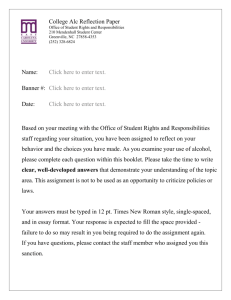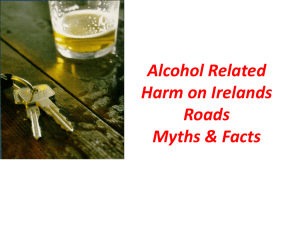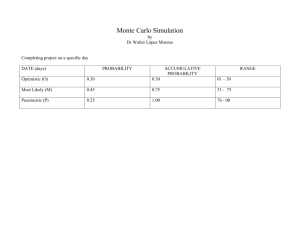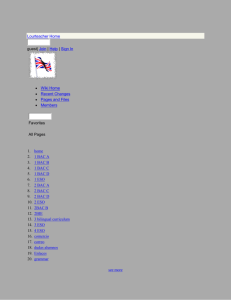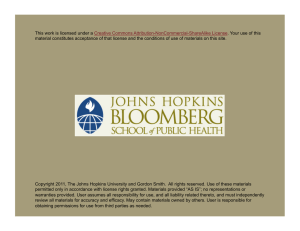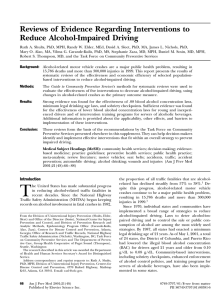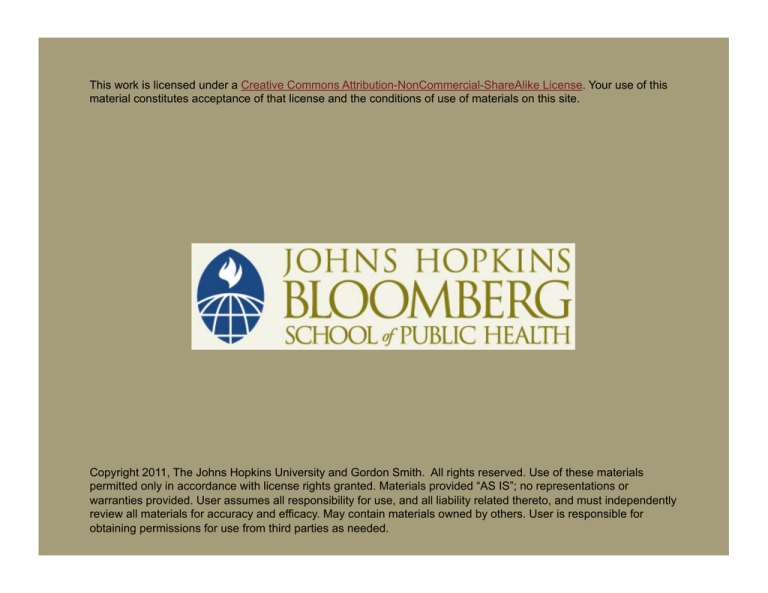
This work is licensed under a Creative Commons Attribution-NonCommercial-ShareAlike License. Your use of this
material constitutes acceptance of that license and the conditions of use of materials on this site.
Copyright 2011, The Johns Hopkins University and Gordon Smith. All rights reserved. Use of these materials
permitted only in accordance with license rights granted. Materials provided “AS IS”; no representations or
warranties provided. User assumes all responsibility for use, and all liability related thereto, and must independently
review all materials for accuracy and efficacy. May contain materials owned by others. User is responsible for
obtaining permissions for use from third parties as needed.
Alcohol
Gordon Smith, MD (MB, ChB Otago), MPH
Professor
University of Maryland
National Study Center for Trauma and EMS
gssmith@som.umaryland.edu
Alcohol and Injuries
What do we know?
What can we do?
3
Lecture Topics
Extent of alcohol involvement in injuries
Measurement and assessment of risk
Case studies and the need for local data
Collecting alcohol data and planning interventions
4
Section A
Extent of Alcohol Involvement in Injuries
How Much of a Problem Is Alcohol?
107,000 deaths attributed to alcohol abuse, 42% of which
(44,940) were due to injuries
147,840 injury-related deaths, 40% (57,885) of which were
attributed to alcohol
- Injury Prevention, 1989
Note: Information from more recent studies is available in the
online library
6
What Is the Role of Alcohol?
How do we assess risk?
What is the evidence?
7
Anecdotal Evidence
“Make not thyself helpless
drinking in the beer shop . . .
falling down, thy limbs will be
broken and no one will give
thee a hand to help thee up.”
The Making of the Scribe
Ani 1500 BCE papyrus
N el Guebaly
Int J of Addictions ‘81
8
Anecdotal Evidence
“The benefits arising from the moderate use of strong
liquor have been experienced in all armies and are not
to be disputed . . .”
— Gen. George Washington
August 15, 1777
9
Descriptive Studies
First descriptive article:
- “Twenty-five fatal accidents occurring to automobile
wagons”
Nineteen drivers used spirits
Six moderate drinkers
Source: (1904). Quart J Inebriety.
10
Impaired Driving Problem in the United States
11,000–12,000 killed by intoxicated drivers
300,000 people injured in drinking driving crashes
$129.7 billion in annual costs to society
1,400,000 drivers arrested annually for DWI or DUI
11
US Alcohol-Related Crash Fatalities
Non Alcohol-Related
1988
47,087
50%
1992
39,250
45%
1999
41,611
38%
2001
41,730
40%
2009
33,808
32%
Source: NHTSA NASS. (2005).
12
Proportion of All Fatally Injured Intoxicated Drivers
Proportion of all fatally injured drivers estimated to have been legally intoxicated
(BAC=>.08) 1982-2008 [-33%]
13
Drivers Involved in Fatal Crashes by BAC Level
FARS 2007 (N = 55,681)
14
Proportion of Crashes that Are AlcoholRelated
Proportion of crashes that are alcohol-related as a function of the number of
vehicles and crash severity
Source: NHTSA
15
Single- and Multiple-Vehicle Fatal Crashes
Single- and multiple-vehicle fatal crashes by time of day and alcohol involvement
(NHTSA)
16
Number of Drinks and BAC in Two Hours of Drinking
17
Metabolism of Alcohol
18
Alcohol Involvement by Cause of Injury Death
Percent of Cases
BAC positive
BAC ≥100 mg/dL
Source: Smith et al. (1999).
19
Percent of Cases
Alcohol Involvement for Unintentional Injuries by Cause
Source: Smith et al. (1999).
20
Alcohol Involvement Increases with Injury Severity
Adult Pedestrians with BAC Levels ≥0.08 g/100 ml From
MVAPED study, South Africa, 1993 (n = 196)
70.0%
In-hospital
deaths
Severe injuries
admitted
Lesser injuries
discharged
Randomly sampled
uninjured adult pedestrians
61.2%
50.9%
10–13%
21
Trauma Patients Admitted: Port Elizabeth, South Africa
Substances abused by injured patients, Trauma patients Port
Elizabeth, South Africa (n = 235)
13.2%
44.3%
Alcohol only
Drugs only
Alcohol and drugs
No substances
40.4%
2.1%
22
Substances Abused by Traffic Trauma Victims
From data from South Africa, 1997 (n = 72)
Pedestrians
(n = 31)
Drivers/riders
(n = 22)
Passengers
(n = 19)
All traffic
(n = 72)
71
0.16 ± 0.1
36.4
0.1 ± 0.08
42.1
0.11 ± 0.1
52.8
0.14 ± 0.1
Alcohol (chronic)
Total cage ≥ 2 (%)
50
6.7
22.3
26.5
Illicit drugs
Cannabis positive (%)
Cocaine positive (%)
White pipe positive (%)
9.0
0
0
14.2
7.1
0
26.7
0
5.3
15.7
2.0
2.0
Alcohol (acute)
BAC positive (%)
Mean BAC (g/100 ml)
23

